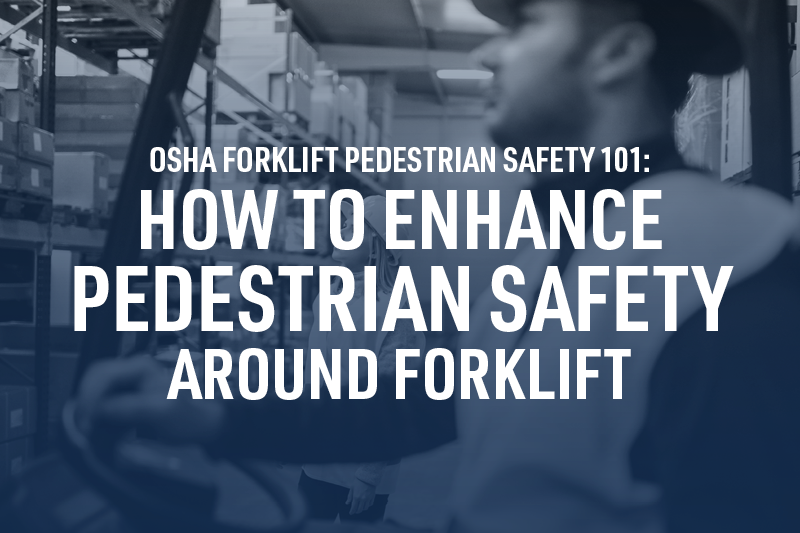2 min read
OSHA Forklift Pedestrian Safety 101: Enhance Safety Around Forklifts
John Wofford
Apr 7, 2025 6:30:00 AM

 OSHA requires that forklift operators receive training, though many agree that the training is shy on the details covering warehouse pedestrian safety. Regardless of how you feel about OSHA rules, you can make your warehouse safer just by following OSHA forklift pedestrian safety requirements.
OSHA requires that forklift operators receive training, though many agree that the training is shy on the details covering warehouse pedestrian safety. Regardless of how you feel about OSHA rules, you can make your warehouse safer just by following OSHA forklift pedestrian safety requirements.
Following OSHA forklift pedestrian safety requirements is essential to ensure your warehouse is maintaining safe distance between forklifts and pedestrians. Confused about where to get started? Check out the OSHA requirements for pedestrian walkways.
Here, we discuss OSHA pedestrian forklift safety best practices and ways you can optimize pedestrian safety around forklifts.
The basics: How to maintain pedestrian safety around forklifts
While pedestrians have the right-of-way when it comes to OSHA forklift pedestrian safety rules, that doesn’t prevent accidents from happening.
Forklifts are dangerous; weighing as much as six cars, despite their smaller size.
Further increasing the difficulty of maintaining pedestrian safety around forklifts, operators must often maneuver around tight spaces with large loads. Decreased visibility leads to decreased pedestrian safety around forklifts.
Avoid accidents by maintaining a safe distance between forklifts and pedestrians
Pedestrian accidents account for more than twenty-five percent of forklift accidents. These accidents are preventable.
The source of many of these accidents? Poor pedestrian safety measures and a lack of awareness for potential hazards.
Create a safer environment for warehouse pedestrian safety
With just a few steps, you can dramatically increase your pedestrian safety around forklifts.
- Use overhead and rear-view mirrors on forklifts
- Ensure alarms and flashing signals are in working order on all warehouse forklifts
- Mark pedestrian walkways in warehouse locations with forklift traffic
- Restrict specific areas to forklift traffic only
- Add handrails to increase pedestrian safety around forklifts
- Limit overhead door access to forklifts and use man doors for pedestrians
Awareness as a method to improve warehouse pedestrian safety
Accidents occur even with the best forklift safety measures. Pedestrians often assume that safety measures prevent accidents, but awareness is essential.
Implementation of OSHA forklift pedestrian safety requirements isn’t enough alone to prevent an accident.
By increasing your team’s awareness of forklift hazards, more incidents can be prevented.
Busting the Myths about Pedestrian Safety Around Forklifts
It’s easy to assume that everyone just ‘gets’ forklift safety, but that’s a costly belief, just like these:
- Forklift safety is just common sense.
- No forklift in sight? It’s safe for me to walk.
- The forklift has brakes- it can stop in time.
- Forklift maintenance is always up to date. No need to worry about unexpected surprises.
- I see the forklift, so the forklift operator can see me.
Bust these myths and get further clarity about how you can improve your warehouse pedestrian safety. Get your forklift safety training today
We’re an authorized dealer for Toyota, Clark, Linde, and Komatsu forklifts and serve customers throughout Alabama, Mississippi, Tennessee and eastern Arkansas.
Please contact us online or by phone 844-LILLYCO (1-844-545-5926) with any questions you have about new or used forklifts. Or come say hello at one of our 13 locations:
Arkansas - Jonesboro
Alabama - Birmingham, Dothan, Irondale, Madison, Mobile, and Montgomery
Mississippi - Belden and Richland
Tennessee - Jackson, Kingsport, Knoxville, and Memphis
Posts by Tag
- Forklift (67)
- Forklift Service (20)
- Electric Forklifts (17)
- Forklift Safety (15)
- Warehouse Automation (14)
- Forklift Attachments (12)
- Product Review (12)
- Toyota Forklifts (12)
- Warehouse Planning (11)
- Parts (10)
- Clark Forklifts (8)
- Pallet Racking (8)
- Customer Solutions (7)
- Loading Docks (7)
- Material Handling Education (7)
- Purchasing Options (7)
- Aerial Equipment (6)
- Forklift Batteries (6)
- Forklift Rental (6)
- Forklift Tires (5)
- Heavy Equipment (5)
- Forklift Accessories (4)
- Forklift Fleet Management (4)
- Forklift Training (4)
- Pallet Jacks (4)
- Products (4)
- Utility Vehicles (4)
- Yard Spotter Trucks (4)
- Komatsu (3)
- Linde (3)
- Specialty Forklifts (3)
- Used Equipment (3)
- Warehouse Doors (3)
- IC Forklifts (2)
- Manitou (2)
- COMBiLift (1)
- Custom Shop (1)
- Forklift Brakes (1)
- Forklift Warranty (1)
- Gehl (1)
- Recruitment (1)









